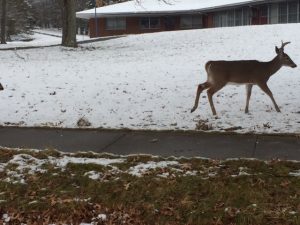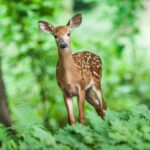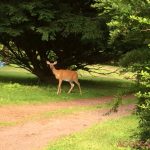Watching deer at the White Haven Center is akin to visiting a petting zoo.
I saw the herd when going to a meeting about the center’s proposed closing.
They were nibbling on the edge of the road so I slowed down, worrying one might run into my car.
No worries.
They stayed still while I photographed them.
Nick Sedon, a pressman at the Standard-Speaker who finished his career at the center, told me the deer were present while he worked there.
Sometimes residents and workers feed them, he said.
“They’re not supposed to but they do. They hang out because they know they’re safe. You can’t hunt there,” Sedon said.
Feeding deer draws a crowd, through which illnesses such as chronic wasting disease can spread.

A buck walks near a road at White Haven Center.
Deer need days to acclimate to new food so human food can make them sick.
Energy they spend going to food drops can outweigh what deer consume, especially for smaller, feeble deer that get shoved away.
Another worker remembered seeing deer throughout his 35 years at White Haven.
He said the center’s acres of grass and shelter from hunters allowed the herd to grow.
Deer seemed to increase on the property when hunting seasons opened.
But he also noticed problems that resulted from feeding deer.
Some people fed deer from their cars, which has another drawback: deer become accustomed to moving vehicles.
Poachers also tried to hunt deer in the center, even at night, which violates several laws, including one that prohibits shooting within 150 yards of any occupied residence.
If you go to White Haven you can see deer up close, though not in their natural habitat, and see the detrimental results of feeding them.

Even after three decades as a reporter at the Standard-Speaker, Kent Jackson still enjoys meeting people, learning more about the community and sharing stories with readers. He currently covers schools but has reported on local government, health, police and the environment. Regularly, he writes about outdoor sports, wildlife and conservation for the Wildlife page on Sundays. Contact: 570-455-3636; kjackson@standardspeaker.com




